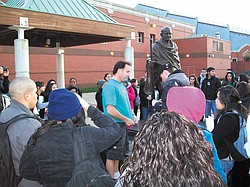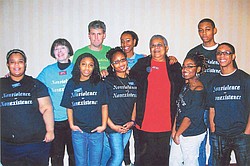Students travel to the Deep South for a history lesson in civil rights
Special to the Vindicator
Standing beside the statue of Mahatma Gandhi outside the Dr. Martin Luther King Center in Atlanta, Jeff Steinberg addresses a group of students who took part in a recent Sojourn to the Past. Steinberg is executive director of Sojourn, a social justice and civil-rights education project that takes students to the Deep South to learn about the modern civil-rights movement of the 1950s and ’60s.
Special to the Vindicator
Eight local high school students were among the 90 others who participated in a recent 10-day Sojourn to the Past. Pictured are, from left, Shameka Walker of Youngstown Early College; Penny Wells of Sojourn, who prepared the students for the trip; Da’Nazha Fludd, YEC; Sean Barron, who accompanied the group; Shaniece Howell, YEC; Shatasia Walker, Chaney High School; Minnijean Brown Trickey, one of the Little Rock Nine; and Brittany Harris, Nigel Baldwin and Cordell Jackon, East High School. Missing the from picture is Gregory Jones of YEC.
By Sean Barron
Shatasia Walker cried briefly, then sat in silence next to a side door at Medgar Evers’ home.
Soon, however, her sadness morphed into deep curiosity.
“I was wondering what [Evers] was thinking about; I wondered if he thought he’d live and what was going through his mind,” the Chaney High School senior said, referring to the moments after the famous civil-rights leader and NAACP field secretary stepped out of his blue Oldsmobile and was shot to death June 12, 1963, in the driveway of his Jackson, Miss., home.
“I kept picturing the man in the bushes and Medgar Evers holding a key in his hand. Was it necessary to shoot him at his home?” Walker continued.
That was one of many reflective and emotional moments Walker and seven other local students found themselves caught up in during their participation last month in Sojourn to the Past, a social justice and civil-rights education project that has taken thousands of students to the Deep South.
The other students were Nigel Baldwin, Brittany Harris and Cordell Jackson, East High School sophomores; Shameka Walker and Da’Nazha Fludd, Youngstown Early College 10th-graders; and Shaniece Howell and Gregory Jones, YEC junior and senior, respectively. The eight joined about 90 high-school students from the San Francisco area for the 10-day, five-state journey that took them to sites — and allowed them to meet people — prominent during the modern civil-rights movement of the 1950s and ’60s.
Toward the trip’s end, all of the students were required to develop action plans to take home based on what they learned and on the six principles of nonviolence. The plans centered around giving back to their communities.
The students, several of their teachers and special guests spent the first three days in Atlanta, where they took part in history lessons at nearby Stone Mountain and the reflective pool surrounding the burial site of Dr. Martin Luther King Jr. and his wife, Coretta Scott. They also visited the King National Historic Site, where they learned about the famous civil-rights leader’s activities just prior to his April 4, 1968, assassination and saw the mule wagon that carried his body afterward.
The students heard a speech by Georgia Congressman John Lewis, whose 1998 book, “Walking with the Wind,” was required reading.
“As a young child, I tasted the bitter taste of segregation and I didn’t like it,” Lewis said before describing King’s powerful influence on him, as well as the head wound he suffered during the March 7, 1965, attack against an estimated 600 marchers on the Edmund Pettus Bridge in Selma, Ala., known as “Bloody Sunday.”
Lewis also recalled the numerous sit-in movements that sprang up throughout the South in which students sat for hours at lunch counters without being served, for example, to protest segregated public facilities.
“We live in a better country because a few brave people decided to get in the way,” he said.
Lewis and the other speakers urged the students and adults to exercise courage to stand up for what’s right and not be “silent witnesses“ to racism and injustice.
For the remainder of the trip, the group took two chartered buses to Selma, Montgomery and Birmingham, Ala.; Meridian, Hattiesburg and Jackson, Miss.; Little Rock, Ark.; and Memphis, Tenn.
Conducting most of the history lessons was Jeff Steinberg, Sojourn’s executive director, who takes students on the trip several times a year.
One of the first lessons Steinberg gave was on the Little Rock Nine, who, in September 1957, integrated Central High School in Little Rock. The five-story school, which looks much as it did in the 1950s, was part of the Sojourn itinerary.
One of the LRN, Minnijean Brown Trickey, spent the entire 10 days with the Sojourn group and conducted a series of sessions.
Participants learned about how many white Central High students continually harassed and threatened Trickey. Afterward, some Sojourn students cried as they watched her years later on “The Oprah Winfrey Show” receive a hug and apology from David Sontag, one of her main tormentors.
A highlight of their Central High visit was a presentation by Elizabeth Eckford, a retired probation officer and another of the LRN. Eckford still suffers from post-traumatic stress disorder because of her ordeal 53 years ago, Steinberg told the students.
“I wanted to come to Central High School to get the best preparation for college,” Eckford said, recalling how an estimated 150 anti-integration demonstrators quickly grew to a strident mob of about 1,000, and how on the first day, National Guardsmen raised their bayonets to prevent her from entering while allowing white students to pass.
Once in school, her tormentors body-slammed, kicked and knocked her down steps, and faced few consequences, Eckford said.
Throughout the trip, Steinberg asked students to each use one word to describe the speakers after their presentations and explain why. Participants also were required to write thank-you letters to the presenters.
Positive descriptions and hugs were in abundance for the Rev. Clark Olson of Asheville, N.C.
The Rev. Mr. Olson, a Unitarian minister, spoke on how he, along with hundreds of other clergy members, went to Selma at King’s behest after the March 7 attack by Alabama state troopers and members of the Dallas County Sheriff‘s Department.
While organizing the Selma-to-Montgomery march, King had theorized that racists wouldn’t attack people of goodwill such as ministers. Mr. Clark cried at times as he recalled the beating by racists outside of a Selma restaurant he and two other Unitarian ministers suffered shortly after their arrival.
The attack took the life of the Rev. James J. Reeb of Boston, who died in a Birmingham hospital from a massive head injury.
Other Selma speakers were Jimmy Webb, who, at age 16, nonviolently stood up to a deputy sheriff, and Joanne Bland, who was on the Pettus bridge during the attack.
In Birmingham, the students visited the 16th Street Baptist Church and Kelly Ingram Park. They also met the Rev. Fred Shuttlesworth, leader of the Alabama Christian Movement for Human Rights, who fought valiantly against segregation by organizing mass demonstrations in the city.
Steinberg often calls the Rev. Mr. Shuttlesworth, King and the Rev. Ralph Abernathy “the big three” of the civil-rights movement.
Mr. Shuttlesworth, 89, who suffered a stroke a few years ago and was unable to speak to the audience, communicated though his wife, Sephira, and expressed appreciation to participants.
On Jan. 8, 2001, President Clinton presented Mr. Shuttlesworth with the Presidential Citizens Medal for his civil-rights work.
Another key player the students met was Jerry Mitchell, an investigative reporter with the Jackson Clarion-Ledger, whose reporting was pivotal in reopening many cold cases and bringing indictments in the murders of several major civil-rights workers decades earlier.
The first KKK member Mitchell’s work helped put behind bars was Byron De La Beckwith, who, in 1994, was convicted of Evers’ murder and given a life prison term.
Mitchell also helped get justice for the family of Vernon Dahmer of Hattiesburg, a wealthy businessman and father of eight who was elected president of the local NAACP. On Jan. 10, 1966, Dahmer was killed when several KKK members shot at and firebombed the family home and store.
“Vernon didn’t believe people would kill him, but I did,” his widow, Ellie, told Sojourn participants while describing how she and her husband took turns staying up at night to watch the house.
“It was a sad day, but Mississippi has come a long way and has a long way to go,” added the couple’s son Vernon Dahmer Jr.
Other presentations were from Reena Evers, Medgar Evers’ daughter, who spoke at the former family home; Angela Lewis, 46, the daughter of slain civil-rights worker James Chaney; and Simeon Wright, who recalled when his 14-year-old cousin, Emmett Till, was visiting from Chicago in 1955 and was brutally mutilated and murdered by two white men.
The trip wrapped up at the Lorraine Motel in Memphis, where King was shot to death on a balcony. The famous motel, which is a civil-rights museum, also was where participants heard from the Rev. Billy Kyles, 76, who was with King just before he was gunned down.
“Hold fast to your dream. I don’t care what it is, it’s your dream,” the Rev. Mr. Kyles said after recalling King’s last speech the night before.
Most of the Youngstown students said the experience helped them feel more empowered and more likely to achieve their short- and long-term goals, deepened their awareness of the link between derogatory language and violence, provided added resolve to stand up against bullying, made it easier to forgive those who had wronged them, and caused them to take the right to vote more seriously.
For the last five years, Penny Wells, a former history teacher in the Youngstown city schools, has primed students for and taken them on the Sojourn trip, which many describe as a life-changing experience.
“Each time I go, it’s like a renewal for me,” she explained. “There’s always something more I gain each time.”
Wells pointed out that she spends countless hours before trips conducting study sessions with students and discussing “Walking with the Wind.” She also arranges Steinberg’s annual visits to Youngstown to speak to schools.
Interested students must write essays based on why they wish to go and what they plan to do afterward, Wells noted, adding that they also have to do well in school and are expected to give back to their communities. Selected students receive independent-study history credits, she continued.
Wells consults with teachers and principals, she explained. The former teacher also tries to garner support from individuals and foundations to offset part of the $2,600-per- student cost, she said, adding that the students also raise part of their own money through fundraising and other efforts.
 43
43


